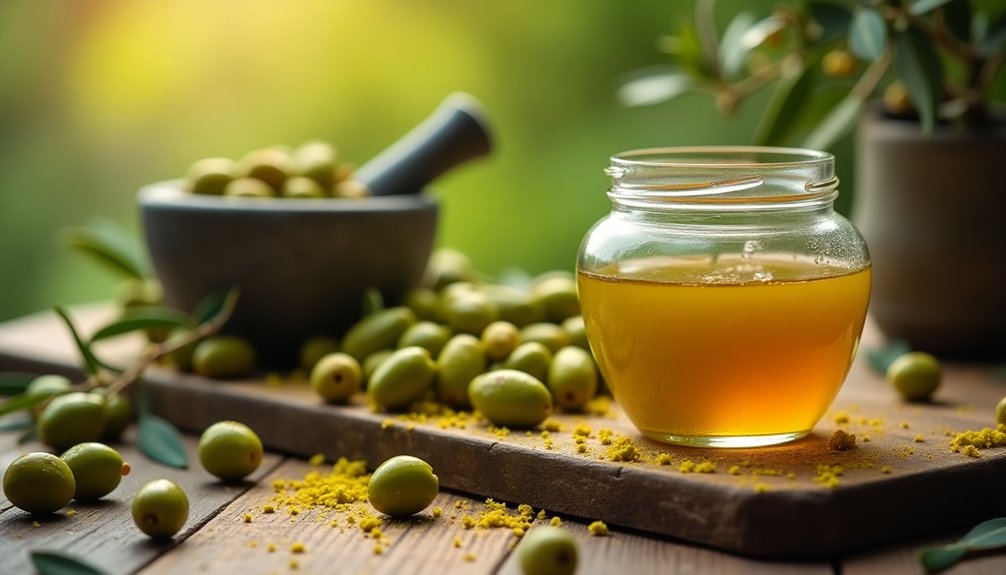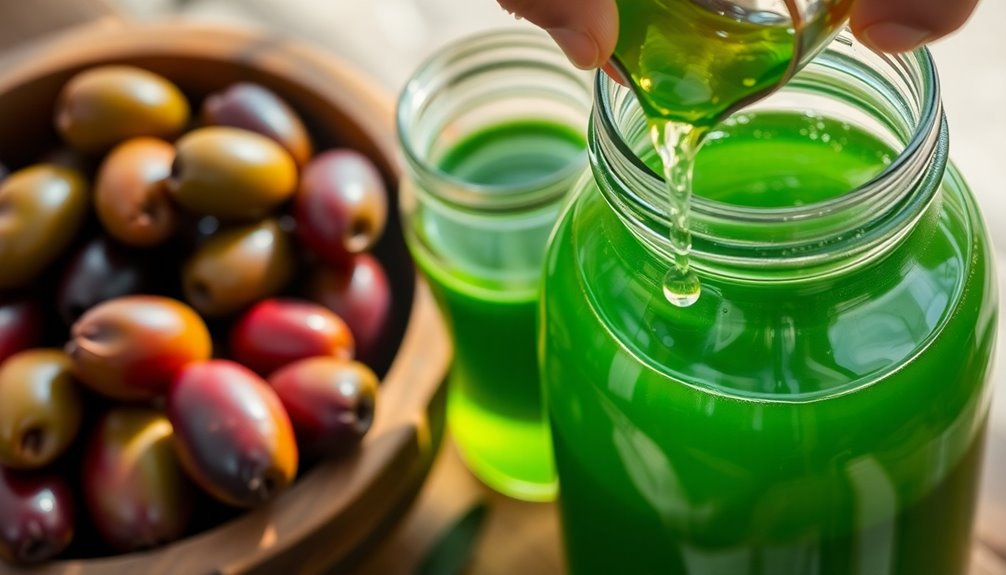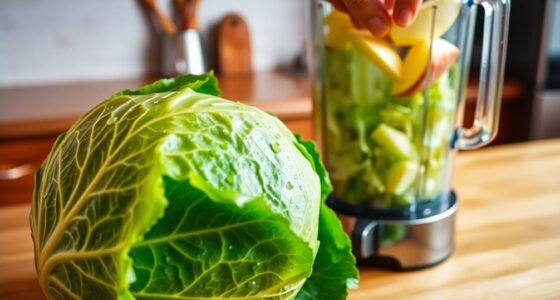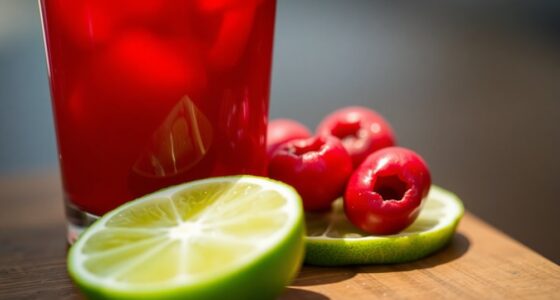To make olive juice, start by selecting brine-cured or lye-cured olives and washing them thoroughly. Pierce each olive with a toothpick to release juices. Next, prepare a brine by mixing one cup of water, one tablespoon of salt, and one teaspoon of vinegar until the salt dissolves. Place the olives in a clean jar, pour the brine over them, and seal it tightly. Shake the jar and let it sit in the fridge to enhance flavors. Want to know more?
Key Takeaways
- Select brine-cured or lye-cured olives, wash them thoroughly, and pierce each olive with a toothpick.
- Prepare a brine mixture by combining one cup of water, one tablespoon of salt, and one teaspoon of vinegar.
- Place the prepared olives in a clean glass jar and pour the brine mixture over them, ensuring they are fully submerged.
- Refrigerate the jar after shaking to let the olives infuse flavors for at least 30 minutes, preferably overnight.
- Crush the olives after resting, strain the mixture, and store the homemade olive juice in the refrigerator.

Making olive juice at home is a simple and rewarding process that enhances your culinary creations. Whether you're looking to elevate your dirty martinis or add a zesty touch to your salads, you'll enjoy the rich flavor that homemade olive juice brings. To get started, you'll need to gather a few key ingredients and follow some straightforward steps.
First, you'll want to select your olives. It's best to choose brine-cured or lye-cured olives for this recipe. Once you've found the right type, wash them thoroughly to remove any excess brine. Then, take a toothpick and pierce each olive. This step is crucial as it helps release the natural juices during the mixing process. You're not just making olive juice; you're maximizing the flavor potential of those delicious olives.
Next, it's time to prepare the brine mixture. Combine one cup of water with one tablespoon of salt and one teaspoon of vinegar in a bowl. Stir until the salt dissolves completely. This mixture will serve as the base for your olive juice.
Now, take your prepared olives and place them into a clean glass jar. Pour the brine mixture over the olives, ensuring they're fully submerged. Seal the jar tightly and shake it vigorously. This helps blend the flavors, allowing the olives to absorb the salty, tangy goodness.
After you've given it a good shake, it's essential to refrigerate the jar of olives. Let them sit for at least 30 minutes, but overnight is best for optimal flavor infusion. The waiting time allows the olives to soak up the brine and develop a richer taste.
Once the resting period is over, you can move on to the next step: extracting additional juice. Carefully crush the olives inside the jar. This helps release even more juice and enhances the flavor profile.
After crushing, strain the mixture through a fine mesh sieve or cheesecloth into another jar. Now you have your homemade olive juice! Store it in the refrigerator, and it'll be ready for all your culinary needs.
Before using the stored olive juice, give it a good shake. This ensures the flavors remain evenly distributed, so you get the most out of every drop. You can incorporate this savory juice into a variety of dishes, from cocktails like dirty martinis to dressings and marinades. It adds a unique, briny depth that's hard to replicate with store-bought options.
Frequently Asked Questions
How Do They Make Olive Juice?
To make olive juice, you start by selecting your olives, washing them to get rid of excess brine.
Then, you pierce each olive with a toothpick to release the juices.
After that, you mix water, salt, and vinegar until the salt's dissolved and pour it over the olives in a jar.
Seal it tightly, refrigerate for a while, and then strain the mixture.
Finally, store the juice in a separate container for later use.
Is Olive Brine the Same as Olive Juice?
No, olive brine isn't the same as olive juice.
While both come from olives, they serve different purposes and have distinct flavors. Olive brine is the salty liquid used to preserve olives, often containing vinegar and water.
In contrast, olive juice is the flavorful liquid extracted from pressed olives, usually less salty.
You'll want to choose one or the other depending on your culinary needs, especially in cocktails or cooking.
How to Replenish Olive Juice?
To replenish olive juice, mix 2½ cups of water with 2 tablespoons of salt and 2 tablespoons of vinegar.
Pour this brine over your olives in the jar, ensuring they're fully submerged but leaving about 4 inches of airspace.
Shake the jar vigorously to distribute the ingredients, then seal it tightly.
Refrigerate for at least 30 minutes, or ideally overnight, to enhance the flavors.
Remember to shake before using for the best taste!
How Long Does It Take to Make Olive Brine?
Making olive brine is like crafting a fine wine; patience is key.
You'll need about 10-15 minutes to mix the ingredients, but don't rush it. For the flavors to truly meld and develop, let the brine sit for at least 24 hours—1-2 days in the fridge is even better.
If you're eager, you can taste it after 30 minutes, but a longer soak yields a richer flavor you won't want to miss.
Conclusion
As you pour the vibrant olive juice into a glass, the rich aroma fills the air, teasing your senses. Just imagine taking that first sip—smooth, briny, and bursting with flavor. The tangy essence dances on your taste buds, leaving you craving more. But wait, what if you've discovered a hidden twist in the recipe? A secret ingredient that elevates your creation beyond the ordinary, transforming your olive juice into an unforgettable experience. Are you ready to savor the surprise?
Cindy thoroughly researches juicing trends, techniques, and recipes to provide readers with practical advice and inspiration. Her writing style is accessible, engaging, and designed to make complex concepts easy to understand. Cindy’s dedication to promoting the advantages of juicing shines through her work, empowering readers to make positive changes in their lives through the simple act of juicing.

















